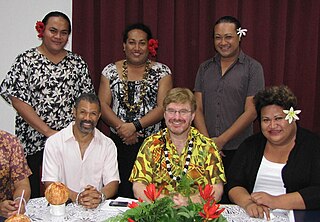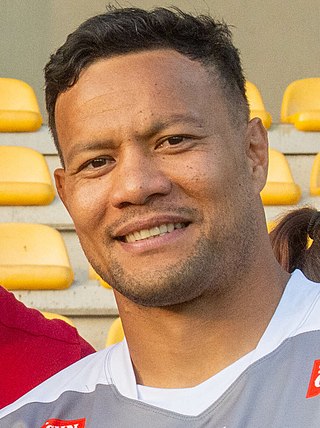
Samoa, officially the Independent State of Samoa and until 1997 known as Western Samoa, is an island country in Polynesia, consisting of two main islands ; two smaller, inhabited islands ; and several smaller, uninhabited islands, including the Aleipata Islands. Samoa is located 64 km (40 mi) west of American Samoa, 889 km (552 mi) northeast of Tonga, 1,152 km (716 mi) northeast of Fiji, 483 km (300 mi) east of Wallis and Futuna, 1,151 km (715 mi) southeast of Tuvalu, 519 km (322 mi) south of Tokelau, 4,190 km (2,600 mi) southwest of Hawaii, and 610 km (380 mi) northwest of Niue. The capital and largest city is Apia. The Lapita people discovered and settled the Samoan Islands around 3,500 years ago. They developed a Samoan language and Samoan cultural identity.

Apia is the capital and only city of Samoa. It is located on the central north coast of Upolu, Samoa's second-largest island. Apia falls within the political district (itūmālō) of Tuamasaga.

German Samoa was a German protectorate from 1900 to 1920, consisting of the islands of Upolu, Savai'i, Apolima and Manono, now wholly within the Independent State of Samoa, formerly Western Samoa. Samoa was the last German colonial acquisition in the Pacific basin, received following the Tripartite Convention signed at Washington on 2 December 1899 with ratifications exchanged on 16 February 1900. It was the only German colony in the Pacific, aside from the Jiaozhou Bay Leased Territory in China, that was administered separately from German New Guinea.

The flag of American Samoa is a flag consisting of a red-edged white triangle pointing towards the hoist charged with a bald eagle clutching a war club and fly-whisk, with dark blue upper and lower triangles. Adopted in April 1960 to replace the "Stars and Stripes" as the official flag of the territory, it has been the flag of the Territory of American Samoa since that year. The colors used epitomize the traditional colors of the United States and Samoa.
The traditional culture of Samoa is a communal way of life based on Fa'a Samoa, the unique socio-political culture. In Samoan culture, most activities are done together. The traditional living quarters, or fale (houses), contain no walls and up to 20 people may sleep on the ground in the same fale. During the day, the fale is used for chatting and relaxing. One's family is viewed as an integral part of a person's life. The aiga or extended family lives and works together. Elders in the family are greatly respected and hold the highest status, and this may be seen at a traditional Sunday umu.

Faʻafafine are natal males who align with a third gender or gender role in Samoa. Fa'afafine are not assigned the role at birth, nor raised as girls due to a lack of daughters, as is often claimed in western media. Rather, their femininity emerges in early childhood, and Samoans recognize them as distinct from typical boys.

Severe Tropical Cyclone Heta was a Category 5 tropical cyclone that caused moderate damage to the islands of Tonga, Niue, and American Samoa during late December 2003 and early January 2004. Heta formed on December 25, 2003; it reached a maximum intensity of 260 km/h (160 mph) and an estimated pressure of 915 hPa before dissipating on January 11, 2004. It was the first named tropical cyclone to form during the 2003–04 South Pacific cyclone season.

Fagatogo is the downtown area of Pago Pago. Located in the low grounds at the foot of Matafao Peak, it was the location of the first American settlement on Tutuila Island. It includes the sub-village of Malaloa. Today, Fagatogo is the government, commercial, financial, and shipping center of Tutuila. It is also the administrative capital of American Samoa. It is the location of the American Samoa Fono (legislature), and is listed in the Constitution of American Samoa as the territory's official seat of government. Its population is 1,737.

The O le Ao o le Malo is the ceremonial head of state of Samoa. The position is described in Part III of the 1960 Samoan constitution.
Samoa rules is a game derived from Australian rules football and rugby union that is occasionally played in Samoa.
Samoan Australians refers to Australian citizens or residents who are of ethnic Samoan descent or people born in Samoa but grew up in Australia. However, there are many New Zealand-born Samoans living in Australia, known as Samoan New Zealand Australians. Most Samoans in Australia live in Sydney, Brisbane and Melbourne. Most people of Samoan heritage speak Samoan as their first language.

Vaʻa is a word in Samoan, Hawaiian and Tahitian which means 'boat', 'canoe' or 'ship'. It is cognate with other Polynesian words such as vaka or the Māori word waka.

Fatu Akelei Feu'u is a noted Samoan painter from the village of Poutasi in the district of Falealili in Samoa. He has established a reputation as the elder statesman of Pacific art in New Zealand.

American Samoa is an unincorporated territory of the United States located in the Polynesia region of the South Pacific Ocean. Centered on 14.3°S 170.7°W, it is 40 miles (64 km) southeast of the island country of Samoa, east of the International Date Line and the Wallis and Futuna Islands, west of the Cook Islands, north of Tonga, and some 310 miles (500 km) south of Tokelau. American Samoa is the southernmost territory of the United States, situated 2,200 miles (3,500 km) southwest of the U.S. state of Hawaii, and one of two U.S. territories south of the Equator, along with the uninhabited Jarvis Island.

Shigeyuki "Yuki" Kihara is an interdisciplinary artist of Japanese and Samoan descent. In 2008, her work was the subject of a solo exhibition at the Metropolitan Museum of Art in New York; it was the first time a New Zealander and the first time a Pacific Islander had a solo show at the institution. Titled Shigeyuki Kihara: Living Photographs, the exhibition opened from 7 October 2008 to 1 February 2009. Kihara's self-portrait photographs in the exhibitions included nudes in poses that portrayed colonial images of Polynesian people as sexual objects. Her exhibition was followed by an acquisition of Kihara's work for the museum's collection.

Alapati Leiua is a Samoan professional rugby union player who plays as a centre for Japan Rugby League One club Shizuoka Blue Revs and the Samoa national team.

American Samoa is an unincorporated territory of the United States, located South East of Samoa and consisting of seven main islands. American Samoa is a predominantly Christian nation, identifying as a region founded by God, however, has become more religiously diverse since the mid-20th century. The religion of Islam was first brought to American Samoa in the mid-1980s by Muslim expatriate workers from government programs. The region received their first native convert in 1985, although Muslim adherents still remain a minority in American Samoan society today. While the population is small, the spread of Islam has been a significant part of the Island’s history.

The Jean P. Haydon Museum is a museum in Pago Pago dedicated to the culture and history of the United States territory of American Samoa. It contains a collection of canoes, coconut-shell combs, pigs’ tusk armlets and native pharmacopoeia. It also houses exhibits on natural history, tapa making, traditional tattooing, as well as a collection of war clubs, kava bowls, and historic photographs. Constructed in 1913 as U.S. Naval Station Tutuila Commissary, the building was home to Tutuila Island's Post Office from 1950 to 1971. The museum has displays of various aspects of the Samoan Islands’ culture and history. It is the official repository for collections of artifacts for American Samoa. Funded by the American Samoa Council on Arts, Culture and the Humanities, it is the venue used for numerous of the cultural resource activities in American Samoa.
Swimming at the 2019 Pacific Games in Samoa was held on 8–13 July 2019 at the Samoa Aquatic Centre in Apia, with the Sheraton Samoa Beach Resort in Mulifanua hosting the open water swim.
Togialelei Safua Akeli Amaama is a Samoan academic. She works as Head of New Zealand and Pacific Histories and Cultures at Te Papa, the National Museum of New Zealand and is the first Pacific person to hold the role. She is also Adjunct Research Fellow in the Museum and Heritage Studies programme at Victoria University of Wellington in New Zealand and an Associate Researcher for the Centre for Pacific Studies at the University of St Andrews in Scotland.